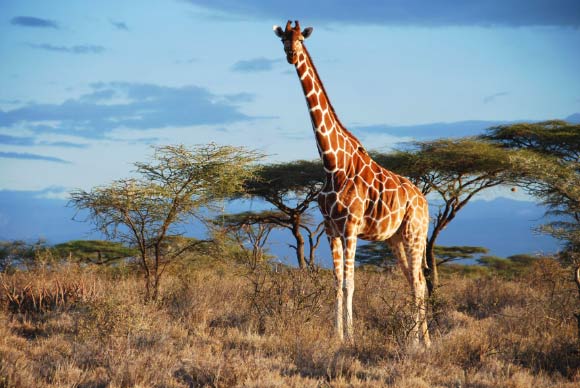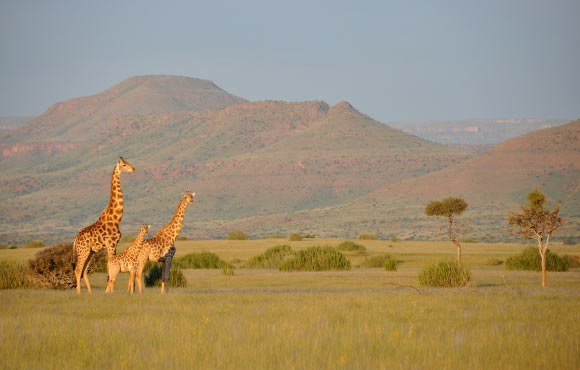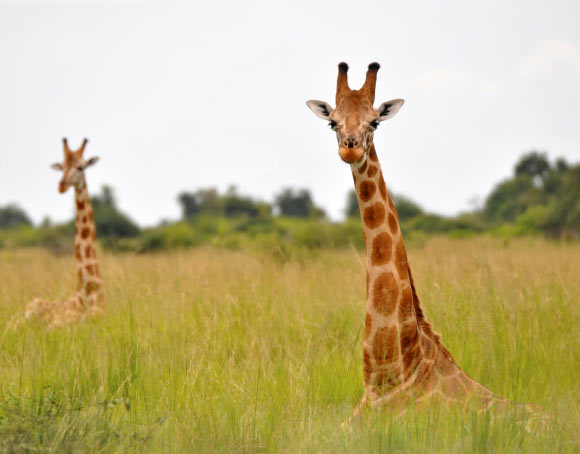Giraffes actually are not one species, but four, according to a new study published in the journal Current Biology.

Reticulated giraffe (G. reticulata) in Samburu NP, Kenya. Image credit: Julian Fennessy / Giraffe Conservation Foundation.
“We were extremely surprised, because the morphological and coat pattern differences between giraffe are limited,” said senior author Prof. Axel Janke, a geneticist at the Senckenberg Biodiversity and Climate Research Centre and Goethe University in Germany.
“Giraffes are also assumed to have similar ecological requirements across their range, but no one really knows, because this megafauna has been largely overlooked by science.”
In the study, Prof. Janke and co-authors examined the DNA evidence taken from skin biopsies of 190 giraffes collected by the team all across Africa, including regions of civil unrest.
The extensive sampling includes populations from all nine previously recognized giraffe subspecies.
“We sampled natural giraffe populations from across their range in Africa, and for the first time individuals from the nominate subspecies, the Nubian giraffe were included in a genetic analysis,” the scientists said.
The genetic analysis shows that there are four highly distinct groups of giraffe, which apparently do not mate with each other in the wild. As a result, giraffes should be recognized as four distinct species.
“We have studied the genetic relationships of all giraffe subspecies from across the continent,” Prof. Janke said.
“We found, that there are not only one, but at least four genetically highly distinct groups of giraffe, which apparently do not mate with each other in the wild. We found this looking at multiple nuclear genes considered to be representative of the entire genome.”
“Consequently, giraffe should be recognized as four distinct species despite their similar appearance.”

Angolan giraffes (G. g. angolensis), previously G. c. angolensis, in Northwest Namibia. Image credit: Julian Fennessy / Giraffe Conservation Foundation.
Those four species include:
(i) southern giraffe (Giraffa giraffa), comprising two distinct subspecies, Angolan (G. g. angolensis) and South African giraffe (G. g. giraffa);
(ii) Masai giraffe (G. tippelskirchi);
(iii) reticulated giraffe (G. reticulata);
(iv) northern giraffe (G. camelopardalis), which includes Nubian giraffe (G. c. camelopardalis), West African giraffe (G. c. peralta) and Kordofan giraffe (G. c. antiquorum) as distinct subspecies.
“The giraffe was first described in 1758 in Linnaeus’ Systema Naturae. As later revealed, Linnaeus based his description on the Nubian giraffe, corresponding to the nominotypical subspecies, G. c. camelopardalis. Linnaeus had never seen a living giraffe and referred to 200-year-old descriptions,” the researchers said.
“The elusive Nubian giraffe from Ethiopia and the South Sudan region is now shown to be part of the northern giraffe,” noted first author Dr. Julian Fennessy, of Giraffe Conservation Foundation.

Nubian giraffe (G. c. camelopardalis), previously Rothschild’s giraffe (G. c. rothschildi). Image credit: Julian Fennessy / Giraffe Conservation Foundation.
Additionally, research into the history of the distinct species showed that their last common ancestor lived about 400,000 years – 2 million years ago, which yields a rate of speciation that is typical for mammals.
“With now four distinct species, the conservation status of each of these can be better defined and in turn added to the IUCN Red List,” Dr. Fennessy said.
“Working collaboratively with African governments, the continued support of the Giraffe Conservation Foundation and partners can highlight the importance of each of these dwindling species, and hopefully kick start targeted conservation efforts and internal donor support for their increased protection.”
“As an example, northern giraffe number less than 4,750 individuals in the wild, and reticulated giraffe number less than 8,700 individuals — as distinct species, it makes them some of the most endangered large mammals in the world.”
“We are now analyzing the amount of gene flow between the giraffe species in greater detail,” the scientists said.
“In addition to expanding the ecological and species distribution data, we want to better understand the factors that limit gene flow and the giraffes’ differentiation into four species and several subspecies.”
_____
Julian Fennessy et al. 2016. Multi-locus Analyses Reveal Four Giraffe Species Instead of One. Current Biology 26: 1-7; doi: 10.1016/j.cub.2016.07.036







